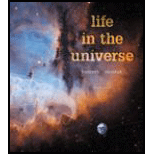
Concept explainers
Detecting Signals. SETI scientists are sometimes criticized for using “old technology” in their search for signals. Perhaps extraterrestrials have moved beyond radio and light signaling and are using something much more sophisticated. Discuss (a) the advantages of radio and light for interstellar communication and (b) any reasonable alternatives you can think of. There is always the possibility that “new physics” will provide faster or more efficient methods for signaling. Do you think this is a reason to limit current SETI efforts?
Want to see the full answer?
Check out a sample textbook solution
Chapter 12 Solutions
Life in the Universe (4th Edition)
Additional Science Textbook Solutions
Essential University Physics (3rd Edition)
College Physics: A Strategic Approach (3rd Edition)
Physics for Scientists and Engineers with Modern Physics
The Cosmic Perspective Fundamentals (2nd Edition)
Sears And Zemansky's University Physics With Modern Physics
- What are the advantages to using radio waves for communication between civilizations that live around different stars? List as many as you can.arrow_forwardIn a globular cluster, astronomers (someday) discover a star with the same mass as our Sun, but consisting entirely of hydrogen and helium. Is this star a good place to point our SETI antennas and search for radio signals from an advanced civilization? Group of answer choices No, because such a star (and any planets around it) would not have the heavier elements (carbon, nitrogen, oxygen, etc.) that we believe are necessary to start life as we know it. Yes, because globular clusters are among the closest star clusters to us, so that they would be easy to search for radio signals. Yes, because we have already found radio signals from another civilization living near a star in a globular cluster. No, because such a star would most likely not have a stable (main-sequence) stage that is long enough for a technological civilization to develop. Yes, because such a star is probably old and a technological civilization will have had a long time to evolve and develop there.arrow_forwardI'm having trouble understanding this. Suppose we have a spaceship about the size of a typical ocean cruise ship today, which means it has a mass of about 130 million kilograms, and we want to accelerate the ship to a speed of 12 % of the speed of light. Suppose you want to generate the energy to get it to cruising speed using matter-antimatter annihilation. How much antimatter would you need to produce and take on the ship? Express your answer using two significant figures.arrow_forward
- The Search for Extraterrestrial Intelligence (SETI) makes use of a huge, multi-billion-dollar network of radio telescopes around the world, all built solely for the purpose of contacting alien civilizations. True Falsearrow_forwardThe Drake equation In 1961 astronomer Frank Drakedeveloped an equation to try to estimate the number ofextraterrestrial civilizations in our galaxy that might be able to communicate with us via radio transmissions. Nowlargely accepted by the scientific community, the Drakeequation has helped spur efforts by radio astronomers tosearch for extraterrestrial intelligence. Here is the equation: NC = N # fp # ne # fl# fi# fc # fLOK, it looks a little messy, but here’s what it means:So, how many ETs are out there? That depends; valueschosen for the many factors in the equation depend onever-evolving scientific knowledge and one’s personalguesses. But now, some questions.a) What quantity is calculated by the first product, N # fp?b) What quantity is calculated by the product, N # fp # ne # fl?c) What probability is calculated by the product fl# fi?d) Which of the factors in the formula are conditionalprobabilities? Restate each in a way that makes thecondition clear.arrow_forwardMost of the stars we can see with the unaided eye in our night sky are hundreds or even thousands of lightyears away from Earth. (The very closest ones are only a few dozen lightyears away, but most are much further.) The vast majority of stars in our galaxy are many tens of thousands of lightyears away. IF intelligent life existed on planets orbiting some of these stars – and that’s a huge IF! – comment on the likelihood and practicality of (a) visiting, (b) communicating with, or (c) verifying the existence of those life forms. Describe how you might go about approaching EACH of these three tasks, or if you think they are even possible. (One or two sentences for each part would be appropriate.)arrow_forward
- O YouTube M Gmail ? Maps UpenVellumHMAC=1bf4397684a361eeedd3b6204a0a6ddc#10001 New Tab O Web design tutori. A MATH180: HW08-.. ering Physics Course Home arses T = Value Units Submit Request Answer Provide Feedback Next> sion.masteringphysics.com/myct/itemView?assignmentProblemID=150494476 MacBook Pro DO F10 F9 FBarrow_forwardThe Search for Extraterrestrial Intelligence (SETI) makes use of a huge, multi-billion-dollar network of radio telescopes around the world, all built solely for the purpose of contacting alien civilizations. True False One of the earliest designs for a fast interplanetary (or interstellar) spacecraft used a series of small nuclear epxlosions to accelerate the vehicle. True Falsearrow_forwardHow Do We know? How would you respond to someone who said, about biological evolution, “Oh, that’s only a theory.?arrow_forward
- Why is traveling between the stars (by creatures like us) difficult?arrow_forwardA radio broadcast was made in 1920. Since that time until 2018, how far has that radio broadcast traveled in light-years? ly In the solar neighborhood there is, on average, one star system per 400 cubic light-years. How many star systems could have heard this broadcast?arrow_forward
 AstronomyPhysicsISBN:9781938168284Author:Andrew Fraknoi; David Morrison; Sidney C. WolffPublisher:OpenStax
AstronomyPhysicsISBN:9781938168284Author:Andrew Fraknoi; David Morrison; Sidney C. WolffPublisher:OpenStax
 Horizons: Exploring the Universe (MindTap Course ...PhysicsISBN:9781305960961Author:Michael A. Seeds, Dana BackmanPublisher:Cengage Learning
Horizons: Exploring the Universe (MindTap Course ...PhysicsISBN:9781305960961Author:Michael A. Seeds, Dana BackmanPublisher:Cengage Learning Stars and GalaxiesPhysicsISBN:9781305120785Author:Michael A. Seeds, Dana BackmanPublisher:Cengage Learning
Stars and GalaxiesPhysicsISBN:9781305120785Author:Michael A. Seeds, Dana BackmanPublisher:Cengage Learning
 Foundations of Astronomy (MindTap Course List)PhysicsISBN:9781337399920Author:Michael A. Seeds, Dana BackmanPublisher:Cengage Learning
Foundations of Astronomy (MindTap Course List)PhysicsISBN:9781337399920Author:Michael A. Seeds, Dana BackmanPublisher:Cengage Learning





